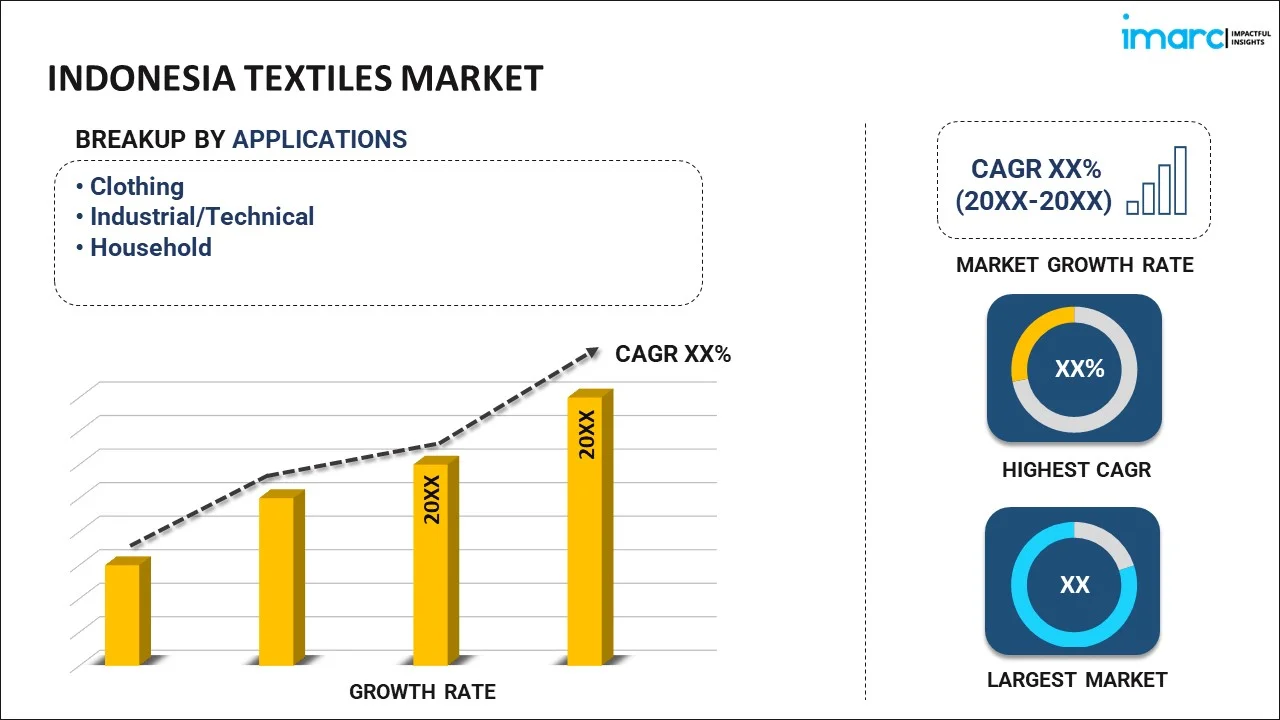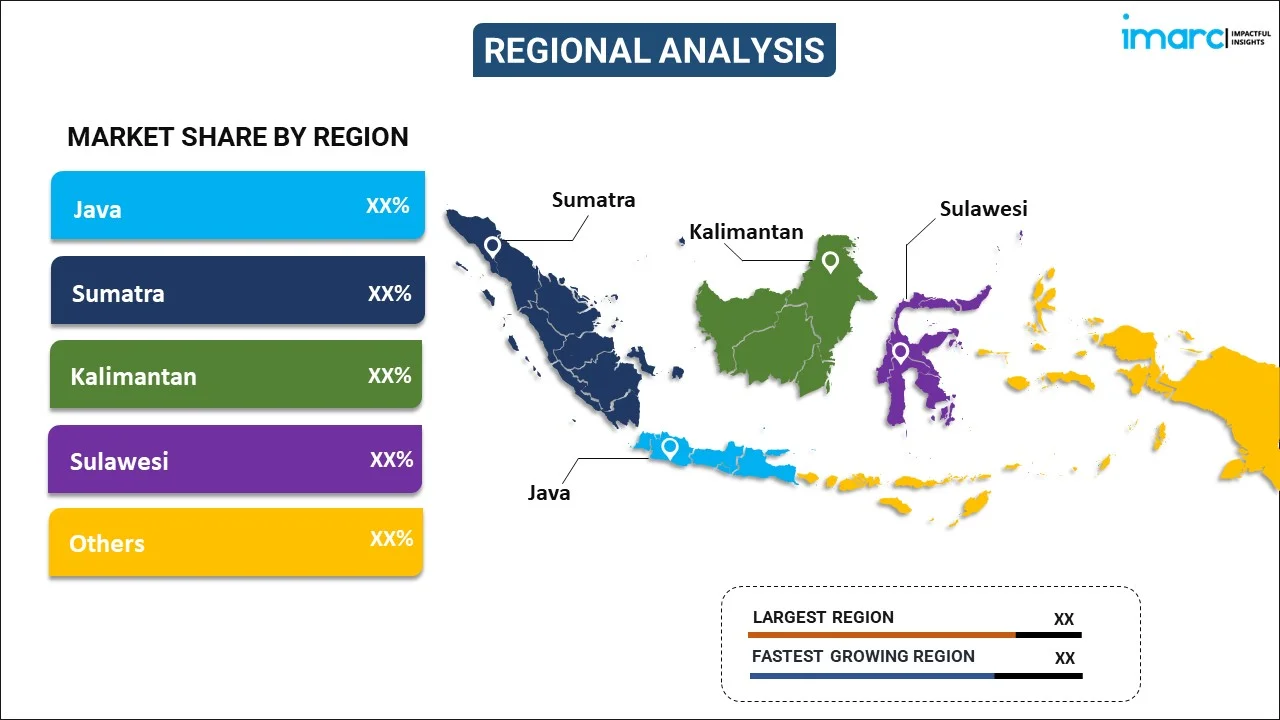
Indonesia Textiles Market Report by Application (Clothing, Industrial/Technical, Household), Material (Cotton, Jute, Silk, Synthetics, Wool), Process (Woven, Non-woven), and Region 2024-2032
Market Overview:
Indonesia textiles market size is projected to exhibit a growth rate (CAGR) of 5.80% during 2024-2032. Rapid economic growth and urbanization across the country, rising middle class with inflating disposable incomes, emerging fashion and e-commerce sectors, and ongoing innovations in textile manufacturing processes and materials represent some of the key factors driving the market.
|
Report Attribute
|
Key Statistics
|
|---|---|
|
Base Year
|
2023 |
|
Forecast Years
|
2024-2032 |
|
Historical Years
|
2018-2023
|
| Market Growth Rate (2024-2032) | 5.80% |
Textiles refer to a diverse category of materials created through the process of weaving, knitting, crocheting, or felting fibers together. These fibers can be natural, such as cotton, silk, wool, and flax, or synthetic, like polyester, nylon, and acrylic. Textiles play a crucial role in various industries, including fashion, home furnishings, and industrial applications. In the fashion industry, they are the primary raw materials used to create clothing and accessories. The choice of textile can significantly impact the comfort, durability, and appearance of the final product. Natural fibers like cotton and silk are prized for their breathability and luxurious feel, while synthetics like polyester offer durability and affordability. The textile industry continually evolves, with ongoing research into sustainable materials and manufacturing processes to reduce environmental impact. Textiles also find extensive applications in home furnishings, including upholstery, curtains, and bedding. They contribute to the aesthetics of interior design and impact the overall comfort and functionality of living spaces. Moreover, industries, such as automotive and aerospace, rely on specialized textiles for applications like seat upholstery, airbags, and composite materials. As a result, the textile industry continues to be a dynamic and essential part of the global economy.
Indonesia Textiles Market Trends:
The Indonesia textile market is experiencing significant growth, driven by a multitude of factors. Indonesia’s growing economy and elevating levels of urbanization represent the primary factors propelling the market forward. As more people migrate to urban areas, there is a heightened need for textiles in the form of clothing, home furnishings, and industrial applications. Besides this, the country boasts a vast population, which ensures a consistent demand for textiles, especially in the clothing sector. Additionally, the expanding middle class in Indonesia has led to an increased capacity for discretionary spending. Consequently, there is an escalating demand for fashionable clothing and home textiles, further supporting the market growth. In line with this, since Indonesia is a significant player in the global textile export sector, the rising export of textiles and garments to different countries is catalyzing the market growth. Furthermore, the Government of Indonesia is taking several favorable initiatives to support the textile industry. These include policies to attract foreign investment, provide incentives for textile manufacturers, and improve infrastructure, which enhances the competitiveness of the sector, thereby fostering market growth. Moreover, with increasing environmental awareness, there is a significant shift toward sustainable and eco-friendly textile production. Therefore, Indonesia is making efforts to adopt more sustainable practices, such as using organic cotton and eco-friendly dyes, to meet global demands for sustainable textiles. In line with this, continuous innovation in textile manufacturing processes and materials, such as the development of high-performance fabrics for technical applications like sportswear and industrial textiles, is driving the market toward growth. Other factors, including the country’s strategic position within the global textile supply chain, the rapid expansion of the fashion industry, and the rise of e-commerce platforms, are also expected to stimulate market growth in the near future.
Indonesia Textiles Market Segmentation:
IMARC Group provides an analysis of the key trends in each segment of the market, along with forecasts at the country level for 2024-2032. Our report has categorized the market based on application, material, and process.
Application Insights:

- Clothing
- Industrial/Technical
- Household
The report has provided a detailed breakup and analysis of the market based on the application. This includes clothing, industrial/technical, and household.
Material Insights:
- Cotton
- Jute
- Silk
- Synthetics
- Wool
A detailed breakup and analysis of the market based on the material have also been provided in the report. This includes cotton, jute, silk, synthetics, and wool.
Process Insights:
- Woven
- Non-woven
The report has provided a detailed breakup and analysis of the market based on the process. This includes woven and non-woven.
Regional Insights:

- Java
- Sumatra
- Kalimantan
- Sulawesi
- Others
The report has also provided a comprehensive analysis of all the major regional markets, which include Java, Sumatra, Kalimantan, Sulawesi, and Others.
Competitive Landscape:
The market research report has also provided a comprehensive analysis of the competitive landscape in the market. Competitive analysis such as market structure, key player positioning, top winning strategies, competitive dashboard, and company evaluation quadrant has been covered in the report. Also, detailed profiles of all major companies have been provided.
Indonesia Textiles Market Report Coverage:
| Report Features | Details |
|---|---|
| Base Year of the Analysis | 2023 |
| Historical Period | 2018-2023 |
| Forecast Period | 2024-2032 |
| Units | US$ Million |
| Scope of the Report | Exploration of Historical Trends and Market Outlook, Industry Catalysts and Challenges, Segment-Wise Historical and Future Market Assessment:
|
| Applications Covered | Clothing, Industrial/Technical, Household |
| Materials Covered | Cotton, Jute, Silk, Synthetics, Wool |
| Process Covered | Woven, Non-woven |
| Regions Covered | Java, Sumatra, Kalimantan, Sulawesi, Others |
| Customization Scope | 10% Free Customization |
| Report Price and Purchase Option | Single User License: US$ 3699 Five User License: US$ 4699 Corporate License: US$ 5699 |
| Post-Sale Analyst Support | 10-12 Weeks |
| Delivery Format | PDF and Excel through Email (We can also provide the editable version of the report in PPT/Word format on special request) |
Key Questions Answered in This Report:
- How has the Indonesia textiles market performed so far and how will it perform in the coming years?
- What has been the impact of COVID-19 on the Indonesia textiles market?
- What is the breakup of the Indonesia textiles market on the basis of application?
- What is the breakup of the Indonesia textiles market on the basis of material?
- What is the breakup of the Indonesia textiles market on the basis of process?
- What are the various stages in the value chain of the Indonesia textiles market?
- What are the key driving factors and challenges in the Indonesia textiles?
- What is the structure of the Indonesia textiles market and who are the key players?
- What is the degree of competition in the Indonesia textiles market?
Key Benefits for Stakeholders:
- IMARC’s industry report offers a comprehensive quantitative analysis of various market segments, historical and current market trends, market forecasts, and dynamics of the Indonesia textiles market from 2018-2032.
- The research report provides the latest information on the market drivers, challenges, and opportunities in the Indonesia textiles market.
- Porter's five forces analysis assist stakeholders in assessing the impact of new entrants, competitive rivalry, supplier power, buyer power, and the threat of substitution. It helps stakeholders to analyze the level of competition within the Indonesia textiles industry and its attractiveness.
- Competitive landscape allows stakeholders to understand their competitive environment and provides an insight into the current positions of key players in the market.
Need more help?
- Speak to our experienced analysts for insights on the current market scenarios.
- Include additional segments and countries to customize the report as per your requirement.
- Gain an unparalleled competitive advantage in your domain by understanding how to utilize the report and positively impacting your operations and revenue.
- For further assistance, please connect with our analysts.
 Inquire Before Buying
Inquire Before Buying
 Speak to an Analyst
Speak to an Analyst
 Request Brochure
Request Brochure
 Request Customization
Request Customization




.webp)




.webp)












